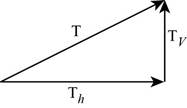
(a)
The centripetal acceleration of the ball.
(a)
Answer to Problem 1SP
The centripetal acceleration of the ball is
Explanation of Solution
Given Info: The radius of the circle is
Write the equation for the centripetal acceleration.
Here,
Substitute
Conclusion:
Thus the centripetal acceleration of the ball is
(b)
The magnitude of the horizontal component of the tension in the string required to produce the centripetal acceleration.
(b)
Answer to Problem 1SP
The magnitude of the horizontal component of the tension in the string required to produce the centripetal acceleration is
Explanation of Solution
Given Info: The mass of the ball is
The horizontal component of tension in the string provides the
Write the equation for centripetal force.
Here,
Substitute
Conclusion:
Thus the magnitude of the horizontal component of the tension in the string required to produce the centripetal acceleration is
(c)
The magnitude of the vertical component of the tension required to support the weight of the ball.
(c)
Answer to Problem 1SP
The magnitude of the vertical component of the tension required to support the weight of the ball is
Explanation of Solution
Given Info: The mass of the ball is
In the vertical direction there is no any motion. This means that the vertical component of tension supports the weight of the ball so that vertical component of tension in the string is equal to the weight of the ball. Thus, total force in the vertical direction is zero.
Write the equation for the weight of the ball.
Here,
The value of
Substitute
Conclusion:
Thus the magnitude of the vertical component of the tension required to support the weight of the ball is
(d)
The vector diagram showing the two components of tension in the string and to estimate the magnitude of the total tension from the diagram.
(d)
Answer to Problem 1SP
The vector diagram showing the two components of tension in the string is given in figure 1.
Explanation of Solution
The following figure gives the component of tension in the string.

Figure 1
Here,
The magnitude of tension

Figure 2
If base of a triangle gives the horizontal component of tension and height of the triangle gives the vertical component of tension, then the length of the hypotenuse of the triangle will give the magnitude of the total tension in the string.
Write the equation for the tension in the string.
Here,
The horizontal component of the tension is equal to centripetal force and vertical component of tension in the string is equal to weight of the body.
Therefore, Substitute
Conclusion:
The vector diagram showing the two components of tension in the string is plotted in figure 1 and the total tension in the string is
Want to see more full solutions like this?
Chapter 5 Solutions
PHYSICS OF EVERYDAY PHENO... 7/14 >C<
 College PhysicsPhysicsISBN:9781305952300Author:Raymond A. Serway, Chris VuillePublisher:Cengage Learning
College PhysicsPhysicsISBN:9781305952300Author:Raymond A. Serway, Chris VuillePublisher:Cengage Learning University Physics (14th Edition)PhysicsISBN:9780133969290Author:Hugh D. Young, Roger A. FreedmanPublisher:PEARSON
University Physics (14th Edition)PhysicsISBN:9780133969290Author:Hugh D. Young, Roger A. FreedmanPublisher:PEARSON Introduction To Quantum MechanicsPhysicsISBN:9781107189638Author:Griffiths, David J., Schroeter, Darrell F.Publisher:Cambridge University Press
Introduction To Quantum MechanicsPhysicsISBN:9781107189638Author:Griffiths, David J., Schroeter, Darrell F.Publisher:Cambridge University Press Physics for Scientists and EngineersPhysicsISBN:9781337553278Author:Raymond A. Serway, John W. JewettPublisher:Cengage Learning
Physics for Scientists and EngineersPhysicsISBN:9781337553278Author:Raymond A. Serway, John W. JewettPublisher:Cengage Learning Lecture- Tutorials for Introductory AstronomyPhysicsISBN:9780321820464Author:Edward E. Prather, Tim P. Slater, Jeff P. Adams, Gina BrissendenPublisher:Addison-Wesley
Lecture- Tutorials for Introductory AstronomyPhysicsISBN:9780321820464Author:Edward E. Prather, Tim P. Slater, Jeff P. Adams, Gina BrissendenPublisher:Addison-Wesley College Physics: A Strategic Approach (4th Editio...PhysicsISBN:9780134609034Author:Randall D. Knight (Professor Emeritus), Brian Jones, Stuart FieldPublisher:PEARSON
College Physics: A Strategic Approach (4th Editio...PhysicsISBN:9780134609034Author:Randall D. Knight (Professor Emeritus), Brian Jones, Stuart FieldPublisher:PEARSON





